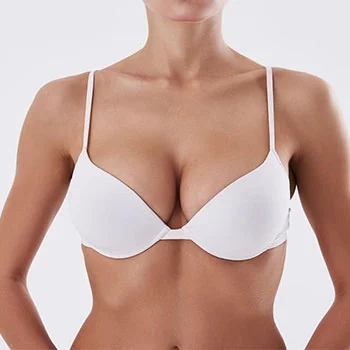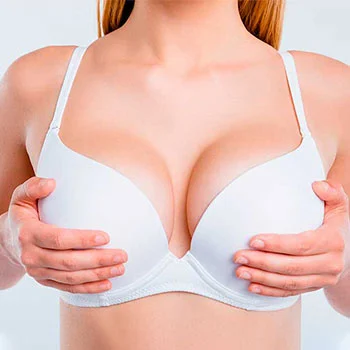What is inverted nipples?
Inverted nipples, also known as retracted nipples, nipple inversion, or nipple retraction, is a condition where the nipple is retracted into the breast instead of pointing outward. This can be a congenital condition, meaning present from birth, or it can develop later in life due to various factors such as breastfeeding, pregnancy, or certain medical conditions.
There are different degrees of nipple inversion, ranging from mild to severe, and it can affect one or both nipples. Inverted nipples can sometimes make breastfeeding more challenging but typically do not pose a serious health risk. However, individuals with inverted nipples may feel self-conscious or unhappy with the appearance of their nipples, leading them to seek correction to achieve a more protruding and symmetrical nipple appearance.
What causes inverted nipples?
Nipple inversion can be caused by a variety of factors, including:
- Congenital: Some people are born with inverted nipples due to genetics. In these cases, the milk ducts and tissue in the breast are simply structured in a way that causes the nipples to invert.
- Changes in breast tissue: Changes in breast tissue from factors such as pregnancy, breastfeeding, or aging can sometimes lead to nipple inversion. These changes can affect the supportive tissues around the nipple, causing it to retract inward.
- Trauma or injury: Trauma to the breast or nipple area, such as from surgery or injury, can also result in inverted nipples. Scar tissue formation or damage to the milk ducts can cause the nipple to retract.
- Underlying medical conditions: Certain medical conditions, such as breast cancer, mastitis (breast infection), or other breast-related disorders, can lead to nipple retraction as a symptom.
- Breastfeeding: Inverted nipples can sometimes become more pronounced or develop during breastfeeding due to the changes in the breast tissue and milk ducts.
It's essential to consult with a healthcare provider to determine the underlying cause of inverted nipples and discuss appropriate treatment options if desired.
What is inverted nipple correction surgery?
Inverted nipple correction surgery, also known as inverted nipple repair, is a procedure aimed at addressing nipples that are retracted or inverted into the breast tissue. The surgery is typically performed by a plastic surgeon or a specialized healthcare provider and involves releasing the tethering tissues that are causing the nipple to invert and bringing the nipple to a more outward position.
How it’s done
Inverted nipple correction surgery is usually performed as an outpatient procedure under local anesthesia. It is typically performed as follows:
- Anesthesia: The procedure is usually done under local anesthesia, which numbs the nipple area while the patient remains awake. In some cases, general anesthesia may be used, especially if additional procedures are being performed.
- Incision: The surgeon will make small incisions at the base of the nipple or around the areola, depending on the specific technique chosen for the correction.
- Release of tethered tissues: The surgeon will then release the tight bands or ducts that are causing the nipple to retract. This step involves carefully separating the tethered tissues to allow the nipple to protrude outward.
- Reshaping the nipple: In cases where tissue grafting or reshaping is needed, the surgeon may use sutures or grafts to create a more prominent and natural-looking nipple shape.
- Closing incisions: Once the correction is completed, the incisions are closed with sutures, and a protective dressing may be applied to the nipple area.
- Recovery: After the surgery, patients are usually able to go home the same day. Recovery time is typically short, and most individuals can return to their normal activities within a few days to a week. The surgeon will provide post-operative care instructions to promote healing and reduce the risk of complications.
It's essential to follow the post-operative care guidelines provided by the surgeon and attend follow-up appointments to monitor the healing process and outcomes of the inverted nipple correction surgery.
Techniques
The specific technique used for inverted nipple surgery may vary depending on the severity of the inversion and the individual's anatomy. Some common approaches include:
- Nipple release: The surgeon may release the tight bands or ducts that are pulling the nipple inward, allowing the nipple to protrude naturally.
- Tissue grafting: In cases of severe inversion, tissue grafting techniques may be used to provide additional support and structure to the nipple, helping it maintain a more outward projection.
- Suture techniques: Various suture techniques can be employed to reshape and secure the nipple in a more prominent position.
How to prepare
To prepare for inverted nipple correction surgery, consider the following steps:
- Consultation: Schedule a consultation with a qualified plastic surgeon or healthcare provider specializing in nipple correction surgery. During the consultation, discuss your medical history, expectations, and any concerns you may have.
- Medical evaluation: Your surgeon may conduct a physical examination of your breasts and nipples to assess the degree of inversion and determine the most suitable treatment plan.
- Discuss expectations: Clearly communicate your goals and expectations for the surgery with your surgeon. Ensure you have a thorough understanding of the procedure, potential risks, benefits, and expected outcomes.
- Medical tests: Your surgeon may request pre-operative tests, such as blood tests or imaging studies, to ensure you are in good health for the procedure.
- Quit smoking: If you smoke, consider quitting or reducing smoking before the surgery, as smoking can interfere with the healing process and increase the risk of complications.
- Medication review: Inform your surgeon about any medications, supplements, or herbal remedies you are taking, as some substances may need to be adjusted before the surgery.
- Arrange for assistance: Plan for someone to drive you home after the surgery and provide support during the initial recovery period.
- Follow pre-operative instructions: Your surgeon will provide specific pre-operative instructions, which may include guidelines on fasting before the surgery and avoiding certain medications.
By following these preparation steps and working closely with your healthcare provider, you can help ensure a smooth and successful inverted nipple surgery experience.
Recovery and aftercare
After inverted nipple correction surgery, it is essential to follow specific recovery and aftercare instructions provided by your surgeon to promote healing and achieve optimal results. Here are some general guidelines for recovery and aftercare:
- Dressing and bandages: Your surgeon may apply a dressing or bandages to the nipple area immediately after the surgery. Follow your surgeon's instructions on when and how to change the dressings.
- Medication: Take prescribed pain medications as directed to manage any discomfort or pain. Avoid taking medications not approved by your surgeon.
- Physical activity: Avoid strenuous activities, heavy lifting, or exercise for the recommended period specified by your surgeon. Gradually resume normal activities as advised.
- Showering: You may be instructed to avoid getting the nipple area wet for a specific period. Follow your surgeon's guidelines on when you can safely shower and how to clean the surgical site.
- Follow-up appointments: Attend all scheduled follow-up appointments with your surgeon to monitor the healing process and ensure proper recovery.
- Compression garments: Your surgeon may recommend wearing a special compression garment or supportive bra to aid in healing and provide support to the surgical site.
- Scar care: Follow your surgeon's instructions on caring for any incision sites to minimize scarring. Avoid exposure to direct sunlight on the incision area.
- Diet and nutrition: Eat a healthy diet rich in nutrients to support the healing process and boost your immune system.
- Monitor for signs of infection: Watch for signs of infection, such as increased pain, swelling, redness, or discharge from the surgical site. Contact your surgeon immediately if you suspect an infection.
- Patience: Allow yourself time to heal and be patient with the results. It may take several weeks to months for the final outcome of the surgery to be fully apparent.
By following these recovery and aftercare guidelines and maintaining open communication with your surgeon, you can help ensure a smooth recovery process and achieve the desired outcomes of nipple retraction surgery.
Risks and complications
Inverted nipple correction surgery, like any surgical procedure, carries certain risks and potential complications. It is important to be aware of these risks before undergoing the surgery. Some common risks and complications associated with nipple retraction repair surgery may include:
- Infection: There is a risk of developing an infection at the surgical site, which may require antibiotics or further treatment.
- Bleeding: Excessive bleeding during or after the surgery can occur, leading to hematoma or other complications.
- Changes in sensation: Some individuals may experience changes in nipple sensation, such as increased or decreased sensitivity, following the surgery.
- Scarring: While efforts are made to minimize scarring, some degree of scarring may occur at the incision sites.
- Asymmetry: There is a possibility of developing nipple asymmetry, where one nipple may appear different from the other in terms of size, shape, or position.
- Recurrence of inversion: In some cases, the nipple may revert to its inverted position following the surgery, requiring additional procedures.
- Delayed healing: Factors such as poor wound healing, underlying medical conditions, or smoking can contribute to delayed healing and potential complications.
- Anesthesia risks: General anesthesia carries its own set of risks, including allergic reactions, respiratory issues, or adverse reactions to medications.
- Unsatisfactory results: While inverted nipple repair surgery aims to improve the appearance of the nipples, there is a possibility that the results may not meet the patient's expectations.
It is essential to discuss these risks and potential complications with your surgeon during the consultation process. By choosing a qualified and experienced surgeon, following pre- and post-operative instructions diligently, and maintaining open communication with your surgeon, you can help minimize the risks and achieve a successful outcome from inverted nipple correction surgery.
Inverted nipple surgery cost
The cost of inverted nipple surgery can vary depending on various factors, including the surgeon's expertise, geographic location, facility fees, anesthesia fees, and the complexity of the procedure. On average, the cost of inverted nipple correction surgery typically ranges from $1,500 to $4,000 or more.
It's important to note that the cost of the surgery may or may not include pre-operative consultations, post-operative follow-up appointments, medications, and supportive garments. Additionally, if the surgery is deemed medically necessary to address functional issues related to inverted nipples, it may be partially or fully covered by health insurance.
To get an accurate estimate of the cost of retracted nipple repair surgery, it is advisable to schedule a consultation with a board-certified plastic surgeon or healthcare provider specializing in nipple correction procedures. During the consultation, the surgeon can assess your specific needs, discuss treatment options, and provide a detailed breakdown of the expected costs involved. It's also recommended to inquire about payment plans or financing options that may be available to help manage the expenses associated with the surgery.
Can inverted nipples be corrected non-surgically?
In some cases, inverted nipples can be corrected non-surgically through conservative methods or techniques. Non-surgical approaches to correct inverted nipples may include:
- Nipple stimulation: Gentle manipulation or stimulation of the nipples through techniques such as massage or the use of a breast pump may help to temporarily evert inverted nipples.
- Nipple shields: Nipple shields or devices designed to apply gentle pressure to the nipple can assist in gradually coaxing the nipples outwards over time.
- Nipple piercing: Nipple piercing has been used as a non-surgical method to correct inverted nipples by promoting tissue growth and encouraging the nipples to protrude.
- Nipple suction devices: Certain suction devices designed for nipple correction can create a vacuum effect that helps pull the nipple outwards.
- Nipple prostheses: Nipple prostheses or molds can be worn under clothing to give the appearance of protruding nipples.
It is important to note that non-surgical methods for correcting inverted nipples may provide temporary or partial improvement, and results can vary depending on the severity of the retraction and individual anatomy. For individuals seeking a more permanent solution or experiencing functional issues related to nipple retraction, surgical correction may be recommended as a more effective option. Consulting with a healthcare provider specializing in nipple correction can help determine the most suitable treatment approach based on individual needs and goals.
Is inverted nipple surgery the same as flat nipple surgery?
Inverted nipple surgery and flat nipple surgery are different procedures aimed at addressing distinct nipple concerns. Inverted nipple surgery is performed to correct nipples that are retracted or inverted into the breast tissue. The procedure involves releasing the tethered tissues causing the inversion and bringing the nipple to a more outward position.
Flat nipple surgery, on the other hand, focuses on increasing the projection of nipples that lie flat against the areola. This procedure aims to create a more prominent nipple shape and projection.
While both surgeries involve enhancing the appearance of the nipple, inverted nipple surgery targets nipples that are inverted or retracted, whereas flat nipple surgery targets nipples that lack projection. The techniques and approaches used in each surgery may vary based on the specific nipple condition and individual anatomy.
FAQs
How long does inverted nipple surgery take?
Inverted nipple correction surgery typically takes about 1 to 2 hours to complete, depending on the severity of the inversion and the specific technique used by the surgeon.
Does inverted nipple correction surgery hurt?
During the surgery, local anesthesia is used to numb the nipple area, so patients usually do not feel pain. After the procedure, some discomfort and mild pain may be experienced, which can be managed with prescribed medications.
Is it possible that the nipples become inverted again after correction?
While inverted nipple repair surgery aims to permanently correct nipple inversion, there is a small possibility of recurrence, especially in cases of severe inversion. Follow-up care and adherence to post-operative instructions can help minimize this risk.
Will inverted nipple surgery leave scars?
Inverted nipple surgery may leave small scars around the nipple area, but efforts are made to minimize scarring and ensure they are discreet. Scarring can fade over time and may vary depending on individual healing.
How long after pregnancy or breastfeeding should I wait to have a nipple surgery?
It is recommended to wait at least 3 to 6 months after pregnancy or breastfeeding before considering inverted nipple correction surgery. This allows time for the breasts to stabilize and ensures optimal surgical outcomes.
Will I be able to breastfeed after inverted nipple surgery?
Inverted nipple surgery can potentially impact breastfeeding, as the milk ducts or tissue may be altered during the procedure. It is advisable to discuss your desire to breastfeed with your surgeon during the consultation to assess the potential impact of the surgery on breastfeeding.




